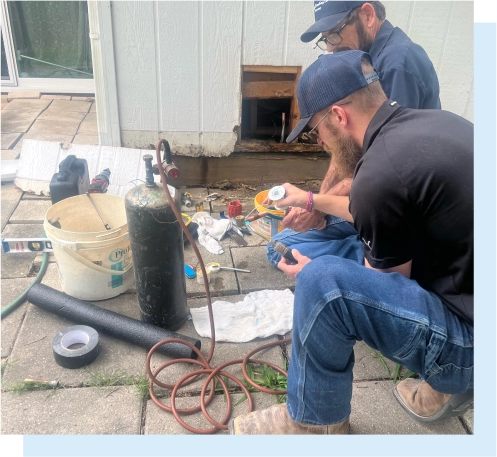
Hidden leaks inside your walls can cause serious damage if left unchecked. Over time, even small leaks can lead to mold growth, structural damage, and costly repairs. Knowing how to identify these hidden leaks can save you from a lot of trouble and expense.
Walls often conceal pipes, making it challenging to detect leaks early. However, there are telltale signs to watch for that can indicate a problem. Being aware of these signs can help you take action before the leak causes significant damage. Many homeowners overlook subtle indicators, but catching them early can prevent major issues.
By understanding the signs of hidden leaks, using the right detection tools and techniques, and knowing what steps to take if you find a leak, you can protect your home from water damage. Additionally, implementing preventive measures can help you avoid future leaks and maintain the integrity of your plumbing system.
Common Signs of a Hidden Leak
Identifying hidden leaks inside your walls starts with recognizing the signs. While these leaks are not always visible, they leave clues that can alert you to a problem.
1. Discolored Walls or Ceilings: One of the most obvious signs of a hidden leak is discoloration on your walls or ceilings. Look for yellow, brown, or copper-colored stains, which indicate water damage. These stains often appear in patches and grow over time.
2. Peeling or Bubbling Paint: When water seeps into your walls, it can cause the paint to peel, bubble, or blister. This happens because the moisture weakens the bond between the paint and the wall surface. If you notice areas where the paint is starting to come off, it’s a sign that water is present.
3. Musty Odors: A musty or moldy smell often accompanies hidden leaks. This odor comes from mold and mildew growth due to prolonged moisture. If you smell something musty and can’t find the source, you may have a hidden leak.
4. Warped or Buckled Walls: Water accumulation behind your walls can lead to warping or buckling. This happens when the wall material absorbs too much moisture and starts to swell. You might notice bumps or curves where the wall should be flat.
5. Unexplained Increase in Water Bill: If your water bill has increased without any obvious reason, a hidden leak could be the culprit. Leaks waste water, leading to higher bills. Monitoring your water usage can help you spot unusual changes.
Be aware of these signs to detect hidden leaks early and take action before more damage occurs.
Tools and Techniques to Detect a Leak
Once you suspect a hidden leak, using the right tools and techniques can help confirm its presence and pinpoint the location.
1. Moisture Meter: A moisture meter measures the moisture levels in your walls. Press the device against the wall surface to detect elevated moisture readings. Higher readings indicate the presence of moisture behind the wall, helping you narrow down the leak’s location.
2. Infrared Camera: An infrared camera detects temperature differences within your walls. Water leaks create cooler spots due to evaporation. By scanning your walls with an infrared camera, you can identify these cooler areas and locate the leak.
3. Listening Devices: Specialized listening devices, such as acoustic leak detectors, amplify the sound of water dripping or flowing behind your walls. Plumbers often use these tools to precisely locate leaks without invasive measures.
4. Visual Inspections: Sometimes, a close visual inspection can reveal the source of a leak. Look for cracks, gaps, or holes in your walls, floors, and ceilings. Check around windows, doors, and pipe connections for any visible signs of water entry.
5. Check Water Meter: To confirm a hidden leak, turn off all water fixtures and record the water meter reading. Wait a few hours and check the meter again. If the reading has changed, it indicates a leak in your plumbing system.
Using these tools and techniques helps you accurately detect hidden leaks. Identifying the source early allows you to address it promptly and avoid further water damage.
Immediate Steps to Take If You Find a Leak
If you find a hidden leak inside your walls, taking immediate steps can help minimize damage and prevent further issues. Here’s what you should do right away:
1. Turn Off the Water Supply: Locate the main water shut-off valve and turn it off. This stops the flow of water and prevents more water from leaking into your walls and causing further damage.
2. Dry the Area: Use towels, mops, and fans to dry the affected area as much as possible. Removing as much moisture as you can helps reduce the risk of mold and mildew growth.
3. Ventilate the Space: Open windows and doors to allow air circulation in the affected area. This aids in drying out the space and minimizes the humidity that can contribute to mold growth.
4. Call a Professional Plumber: Contact a licensed plumber to inspect and repair the leak. A professional can accurately diagnose the problem and fix it efficiently. They can also check for additional hidden leaks or related issues in your plumbing system.
5. Document the Damage: Take photos and notes of the damage for your records and for insurance purposes. This documentation can be useful if you need to file a claim.
Following these steps helps ensure that the leak is properly addressed and reduces the potential for long-term damage to your home.
Preventive Measures to Avoid Future Leaks
Preventing future leaks involves taking proactive steps to maintain your plumbing system. Here are some effective measures:
1. Regular Inspections: Schedule regular plumbing inspections to catch potential problems early. A professional plumber can identify worn-out pipes, loose connections, and other issues that could lead to leaks.
2. Monitor Water Pressure: High water pressure can stress your pipes and cause leaks. Use a pressure gauge to check your home’s water pressure. If it’s too high, consider installing a pressure-reducing valve to keep it at a safe level.
3. Insulate Pipes: Insulate your pipes, especially those in unheated areas like basements and attics. Insulation helps prevent pipes from freezing and bursting during cold weather.
4. Install Leak Detectors: Place leak detectors near areas prone to leaks, such as under sinks, near water heaters, and in basements. These devices alert you to the presence of water, allowing you to address leaks early.
5. Fix Small Issues Promptly: Don’t ignore minor drips or slow leaks. Even small issues can turn into major problems if left unattended. Fix small leaks promptly to prevent them from developing into bigger issues.
By taking these preventive measures, you can reduce the likelihood of future leaks and maintain a healthy plumbing system.
Conclusion
Detecting and addressing hidden leaks inside your walls is crucial for maintaining the integrity of your home. Recognizing the signs of hidden leaks, using the right tools and techniques, and taking immediate steps when a leak is found can help you minimize damage. Additionally, implementing preventive measures can keep your plumbing system in top condition and prevent future leaks.
If you need professional help with leak detection or any plumbing issues, George Plumbing Co., Inc. is here to assist you. Our experienced team can handle everything from minor repairs to comprehensive inspections. Contact George Plumbing Co., Inc. today for reliable and expert San Antonio plumbing services to ensure your home stays safe and leak-free.





